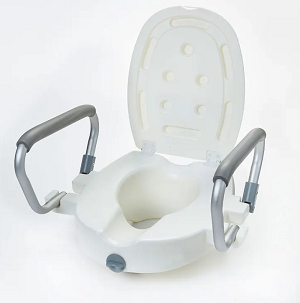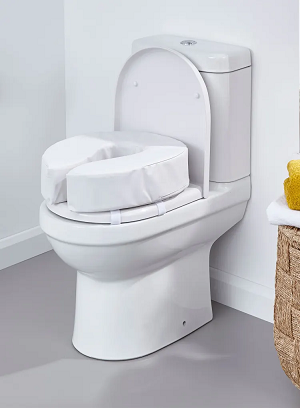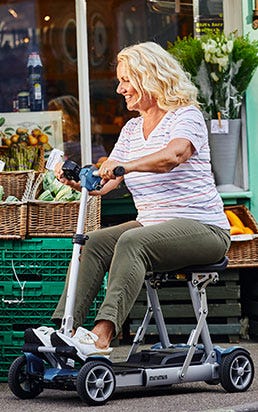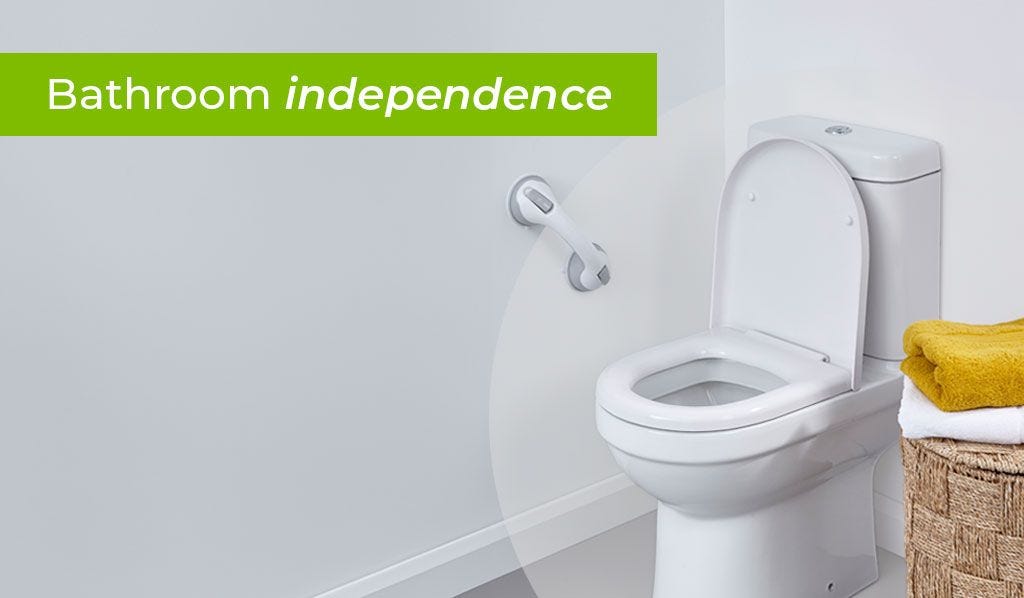Toilets
Let’s face it, although an essential room in the home, the one housing your toilet is often the smallest and hardest to move around in!
Whether a downstairs loo or in an upstairs full suite bathroom, the space in UK homes is often tight and unforgiving if you have mobility struggles. Add to this the fact that toilets are notoriously low, and then anyone with difficulty transferring has a further hurdle to conquer.
Bathrooms continue to be a very common place for falls, so proactive considerations to your environment can only be helpful.
Why Do I Struggle?!
Toilets are historically produced at a set height to make them useable for the masses. I’m sure if you are 5’10ft or more, regardless of any health or movement limitations, you may have already noticed that they feel quite low!
One size doesn’t always fit all, more noticeably so when you begin to experience muscle weakness, joint pain or balance problems.
Seated transfers rely on a strong core and powerful lower limbs to push you up and hold you steady, but it’s these large joints in your lower half, your hips, your knees, that are prone to arthritis and stiffness, making transfers difficult.
Using your upper body to share the load helps, but as toilets don’t have handles or arms, you’re often left clutching for the nearest sink or radiator – for me this a reg flag, a warning sign that you may need some subtle environmental changes.
If you have a hernia or have had surgery, you may have been advised to avoid putting strain on your core during your recovery. If you’re recovering from a hip replacement you may be told to avoid sitting low for a few months. A raised toilet set, with or without arm rests, a floor mounted frame, even a rail on the wall can all help, but which is best?
What Is The Best Toilet Aid For Me?
 Identifying what is best for you is dependent on a number of factors. The first is your function -what movements are you finding difficult? What is the cause of your problems? Are the struggles long or short term?
Identifying what is best for you is dependent on a number of factors. The first is your function -what movements are you finding difficult? What is the cause of your problems? Are the struggles long or short term?
Then second is your environment – consider the space in the bathroom, think about who else uses this room and whether you need a walking aid in the room too. If you have more than one toilet, you may need an entirely different aid for each room dependent on the layouts.
With wall mounted toilets offering their set up at a variety of heights, investing in an entirely new toilet could be an option to discretely address your function changes, particularly if you have a chronic transfer problem and plan to stay in your property for a while.
However, with the considerable cost this involves, and the time required to install, a simple after-market add on could often be enough to make you independent.
There Are Plenty of Toilet Aid Options
 Raised toilet seats have been a staple feature in the OT repertoire of equipment recommendations for years, because of their simplicity and practicality.
Raised toilet seats have been a staple feature in the OT repertoire of equipment recommendations for years, because of their simplicity and practicality.
With padded seats now available with our Riviera Padded Toilet Seat, those who have stoma care or continence routines to perform can sit for longer with more comfort.
However, raised seats are not without fault. Preventing the toilet lid from closing is an issue, a lack of arm support is equally an omission, but with modernised designs like the Europa Toilet Seat, raised seats can now help a wider spectrum of people.
Its swing away arms are very handy if you ever need to transfer from the side, and the lid means you can still keep bacteria enclosed. The arms can help you push up without causing trip hazards around the base of the toilet.
With some thoughtfully positioned grab rails you may even be able to leave your walking aid at the door!
When thinking of adding rails to your room, the positioning is crucial. In general, a horizontal rail is good to assist sitting, whereas diagonal or vertical rails are good to pull up to standing.
Where you mount them is highly dependent on your height, reach and strength, and the rail length is dependent on purpose. As a result, if you’re not having an OT assess and advise you on this, it’s a great idea to start with suction rails and have a few trials to see what works best where before committing to screws in walls!
Toilet frames are often issued by care teams as a short-term measure but as they are cumbersome, they can restrict space, and sometimes even add to your falls risks, so check the space around your toilet before finalising any options.
I would always recommend keeping your floor spaces clear and level whenever moving around. Lift that bath mat as soon as you can - use a grab hand if needs be!
Balancing Your Choices
Making the right choice for your needs is important, but so is access to a ‘choice’, a variety of options. What would best suit your needs might not suit your taste.
Although the introduction of Part M to the building regs has enforced some changes to new build designs, and more consideration is being given to accessibility in modern housing designs, there is still a huge scope for improvement, particularly in bathrooms, to improve independence.
Sometimes we choose form over function, sometimes the aesthetics are irrelevant. Thankfully, we have a mobility equipment market that is listening to your opinions and there is more variety than ever before. If you’re overwhelmed with choice take a look at some of my bathroom reviews, or contact your local OT for some individualised advice.


 Price Match Promise
Price Match Promise
 Next day delivery, 7 days a week
Next day delivery, 7 days a week
 Nationwide Showrooms
Nationwide Showrooms
 Rated Excellent
Rated Excellent






